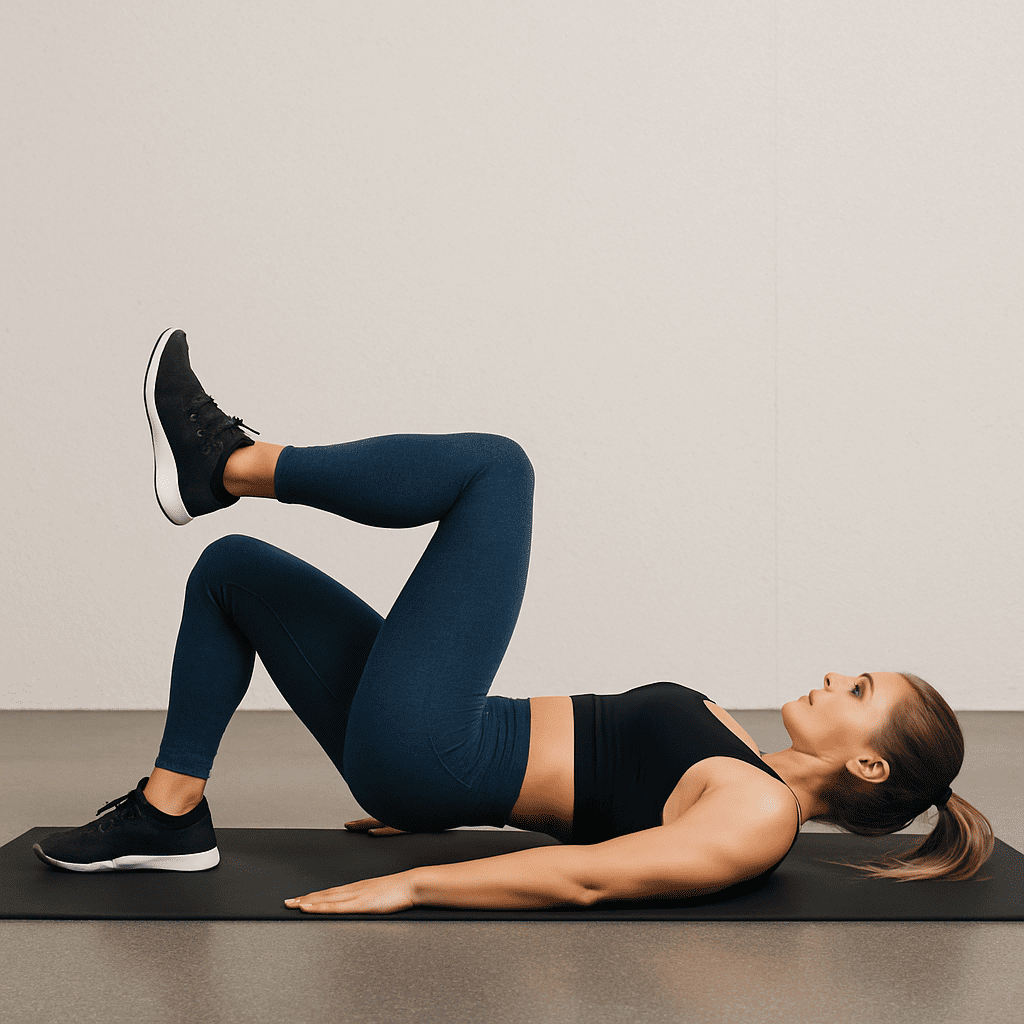9 de May de 2025
Supine Marches: Exercise Guide, Tips and Benefits
Supine marches are a foundational core exercise designed to build control, stability, and coordination through slow, deliberate movement. Performed while lying on your back, this exercise strengthens the deep core muscles while minimizing strain on the spine, making it ideal for beginners, rehab settings, or warm-ups in athletic programs.

What Are Supine Marches?
Supine marches involve lying face-up (supine) with your knees bent and feet flat on the ground or elevated, then slowly lifting one foot at a time in a marching pattern. The goal is to keep your pelvis and lower back stable throughout the movement. Often used in physical therapy and strength and conditioning programs, they target deep core stabilizers and reinforce postural control, coordination, and proper breathing patterns.
How to Do Supine Marches Properly
- Lie on your back with your knees bent at 90 degrees and feet flat on the floor or lifted into tabletop position.
- Engage your core by drawing your belly button toward the floor and pressing your lower back into the ground.
- Lift one foot a few inches off the ground, keeping the opposite leg and pelvis stable.
- Lower the foot with control and repeat the movement with the opposite leg.
- Perform 2–3 sets of 10–15 reps per leg, keeping the movement smooth and deliberate.
Tip: Avoid letting your lower back arch or your hips rock side to side. Controlled movement is more effective than speed.
Muscles Worked by Supine Marches
Supine marches primarily engage the core and hip stabilizers:
- Transverse abdominis: The deepest abdominal muscle, essential for spinal stabilization.
- Rectus abdominis: Helps maintain trunk posture and control.
- Obliques: Assist in resisting rotation and promoting side-to-side stability.
- Hip flexors: Assist in lifting the legs while maintaining core engagement.
Benefits of Supine Marches
- Improved Core Stability: Strengthens the muscles responsible for stabilizing the spine and pelvis.
- Low-Impact Movement: Gentle on the joints and spine, making it accessible to a wide range of fitness levels.
- Better Postural Control: Reinforces a neutral spine and enhances awareness of pelvic alignment.
- Excellent for Rehab and Beginners: Introduces fundamental motor control without high load.
- Versatile Exercise: Easily integrated into mobility flows, activation drills, or cooldowns.
Common Mistakes to Avoid
- Lower Back Arching: Keep your spine neutral and maintain abdominal engagement.
- Overly Large Movements: Small, controlled lifts are more effective and reduce compensation.
- Holding Your Breath: Practice rhythmic breathing to stay relaxed and maintain core engagement.
- Rushed Repetitions: Avoid quick or jerky movements that reduce the effectiveness of the exercise.

Variations of Supine Marches
- Tabletop Supine March: Raise your legs to 90 degrees for increased core engagement.
- Band-Resisted March: Place a mini band around your feet to increase tension and demand.
- March with Arm Reach: Extend the opposite arm with each leg lift to challenge cross-body stability.
- Dead Bug March: Progress into full dead bug variations with alternating arm and leg movements.
How to Include Supine Marches in Your S&C Workout
Use supine marches in warm-ups, mobility flows, or core-focused sessions. Aim for 2–3 sets of 10–15 reps per side, 2–3 times per week. This exercise complements other stability movements like glute bridges or planks and can help athletes develop a solid foundation before progressing to more dynamic lifts. Supine marches are especially useful in managing fatigue and maintaining movement quality during periods of high training volume.
FAQs About Supine Marches
What do supine marches work?
They strengthen the deep core muscles, especially the transverse abdominis, and promote pelvic stability through unilateral leg movement.
What are the benefits of supine exercises?
Supine exercises are low-impact and ideal for strengthening the core without stressing the spine, making them perfect for rehab, beginners, and postural control.
What are lying marches?
Lying marches are another name for supine marches—slow, alternating leg lifts performed while lying on your back with an emphasis on core control.
What does marches exercise do?
Marches improve neuromuscular coordination, core strength, and pelvic stability, all of which are essential for athletic performance and injury prevention.
Supine marches are a simple yet highly effective tool to improve core stability and movement control. Whether you’re starting a new strength and conditioning program, recovering from injury, or working on foundational technique, this exercise can support your goals. Its low-impact nature also makes it ideal for recovery phases or sessions focused on reducing fatigue without compromising training quality.
